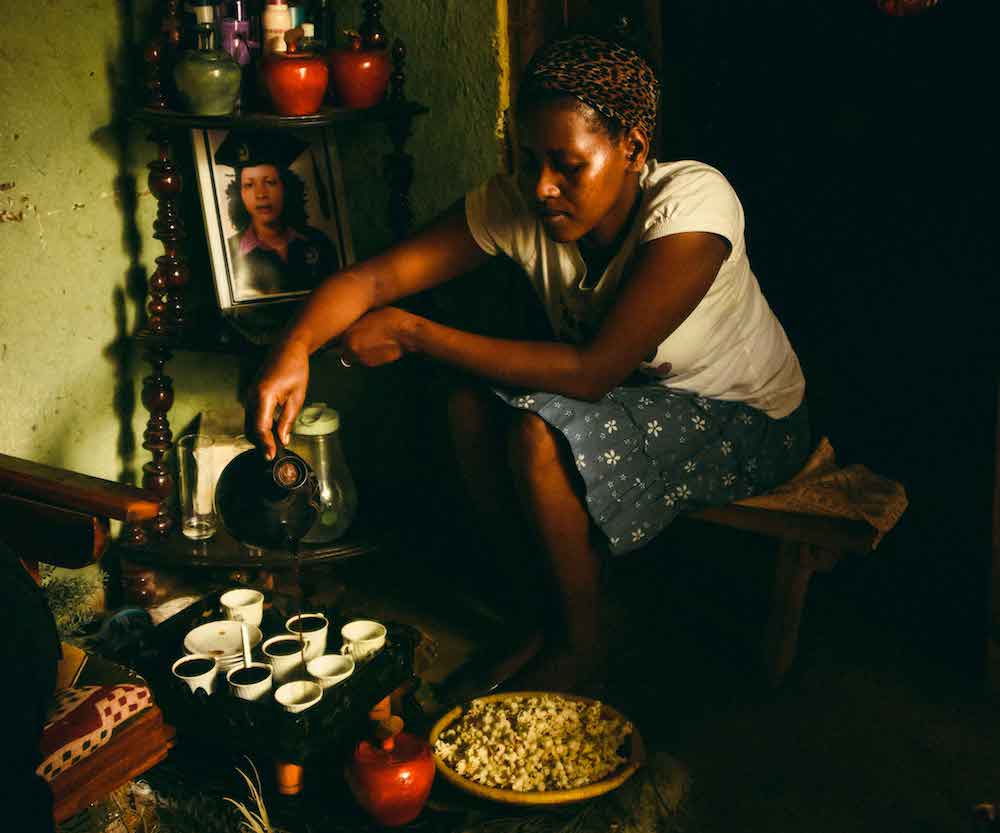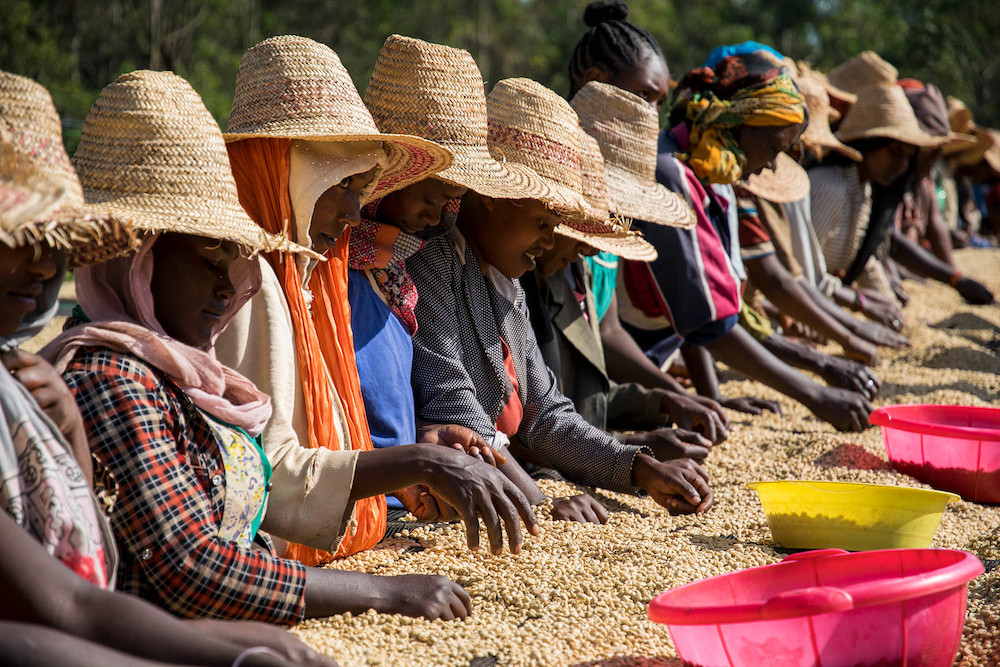Finding Calm—and Connection—in Coffee Rituals
When I arrived from the Philippines to the airport in the city of Gondar in northern Ethiopia early last year—before the pandemic started—I was greeted with an intensely flavorful cup of coffee. All arriving passengers were welcomed in the same way. The East African country, historically known as Abyssinia, was already living up to my expectations as the widely regarded “birthplace of coffee.”
But it was in the succeeding days, as I trekked the Simien Mountains northeast of Gondar, that I came to truly appreciate the coffee as a source of comfort and warmth on the frigid, rugged peaks. At the start of each day, our guides would prepare coffee alongside a light meal. At the end of our daily trek of around 15–20 kilometers, coffee would once again make an appearance as we awaited dinner.
In Addis Ababa, the capital, I encountered more layers of Ethiopian coffee culture. In the traditional shops and restaurants, women, often dressed in traditional clothing, performed the buna ceremony: the name in the Amharic language for a coffee ritual whereby beans are roasted, prepared, and then served as a rich, bittersweet beverage.
I also went to cafés that showcased Ethiopian culture while conveying a more cosmopolitan vibe. In these shops, people were hanging out and studying—just like they do in coffee shops in other parts of the world. In Tomoca Coffee, one of the famous cafés, a paraphrased quote attributed to the French novelist and playwright Honoré de Balzac hung from the ceiling: “When you drink a cup of coffee, ideas come in marching like an army.”
What struck me was the diversity and complexity of coffee within the country, with each region and woreda (district) representing distinct varieties. I couldn’t detect all the tasting notes people often used to describe the coffee, such as blueberry and bergamot. Nor could I distinguish the beans from Sidama from those of Harrar—two of the most famous coffee-producing regions in the country. But I could appreciate the fruity, floral notes that Ethiopian coffee is known for among connoisseurs.
When it was time for me to return home to the Philippines, I bought 6 kilos of coffee from different regions of Ethiopia, intending to give some to my friends. As it turned out, those 6 kilos became my lifeline throughout the first 100 days of the pandemic in the Philippines.
Coffee shops in the Philippines started reopening in May. But the need to fill out contact tracing forms and wear face masks (and even face shields) took the joy out of going to my local Starbucks. I no longer wanted to sit at my favorite table, or even stand in line to get a coffee drink to go.
I am hardly alone in feeling the loss of my daily coffee routine during the pandemic. But, like many others, I soon learned a new ritual: I started preparing my own coffee, from grinding the beans to brewing them—something I had never done before.
As an anthropologist, I also started thinking more about the “social life” of coffee, or how the drink has become so deeply integrated into many people’s daily routines. Globally, estimates show that people consume over 2 billion cups of coffee every day.
While my own research doesn’t focus primarily on coffee, I’ve often encountered it while exploring other topics. For instance, as part of my fieldwork on protected areas in the mountains of Mindanao in the southern Philippines, I met volunteer forest guards who hoped that coffee production would help wean nearby communities off destructive forest practices such as logging—and ensure the sustainability of the mountains themselves.
Some anthropologists have followed coffee’s travels to better understand wide-reaching processes of globalization. Through fine-grained ethnographies, they explore the blend of local and global influences that find their way into each cup and each café. For instance, scholars studying the rise of Starbucks and other global coffee shop chains have noted how the music, artwork, interior decor, global newspapers, and other “signifiers of the international coffee trade” all evoke a sophisticated, worldly sensibility that forms part of the appeal for consumers. I saw a glimpse of this in Addis Ababa, where cafés draw inspiration not just from the Ethiopian culinary traditions but from Starbucks itself.
In the Philippines, as in other parts of the world, coffee shops also represent what researchers have called a “third place” outside of the home and workplace—neither totally private nor totally public. These spaces offer their regular customers a sense of familiarity, comfort, and even community.
But the coffee itself plays a major role too. Depending on the method of preparation, a cup of coffee contains 60–100 milligrams of caffeine—a central nervous system stimulant that makes people feel less sleepy and more alert.
Surely, those of us who have sat through a boring meeting or struggled to meet a grueling deadline can relate to the character in Gabriel García Márquez’s short story “Bon Voyage, Mr. President” who asked for an espresso “strong enough to wake the dead.” Such is the association of coffee with wakefulness and productivity that some cultural historians relate the rise of coffee with the demands of modernity.
Coffee matters to people because of the ritual involved.
Beyond its stimulating effects, the origins of the coffee itself also count, especially to a growing number of connoisseurs.
Consumers of specialty coffee pay close attention to the particular qualities and tasting notes associated with each variety’s terroir, or the growing conditions and farming methods specific to the places where beans are grown, harvested, and processed. In Ethiopia, specialty beans from plantations such as Gesha Village are highly sought after not just because of their taste, but also because of the farmers’ careful methods of selection and cultivation.
Finally, of course, coffee matters to people because of the ritual involved. Indeed, the act of drinking coffee reenacts the pre-pandemic “normal” of being able to travel and work. If nothing else, it gives me a sense of control: While many things have changed, the ability to enjoy my coffee ritual has remained.
I ground the last of my Ethiopian coffee beans in June. Thankfully, by then I had discovered that it was actually possible to buy all kinds of freshly roasted beans in the Philippines—including beans from all the Ethiopian regions, albeit at three times (or more) the price I had paid during my visit.
Meanwhile, coffee farmers around the world face risks and challenges in growing the beans, from pests and drought to the unpredictable shifts of global markets. While the “Ethiopia” label can command a premium on the global coffee market, the coffee farmers themselves struggle to make a profit. That’s because most of the markup on coffee occurs at the end of the production chain, when the beans get consumed.
Ethiopia is learning to capitalize on the increasing demand, not least by including coffee as part of their tourism branding. In early 2020, they organized a “Cup of Excellence” competition that aimed to promote specialty coffee with the hope of improving famers’ incomes. However, with the pandemic disrupting the economy, in general, and the coffee industry, in particular, it remains to be seen how coffee growers will manage.
A cup of coffee may seem simple and ordinary. But its existence relies on numerous itineraries and diverse universes of flavors and technologies. Every sip of a café latte I consume these days in the Philippines comes from Ethiopian beans that are ground by a machine made in the U.S., brewed in a glass contraption made in Japan, and mixed with milk from local cows.
As another new year begins, the pandemic continues—and travel restrictions in the Philippines make my trip last year to Addis Ababa seem more distant than ever. But just as the warm coffee in the Simien Mountains served as a source of comfort after each long day of trekking, the iced coffee at home makes each day more bearable.


































